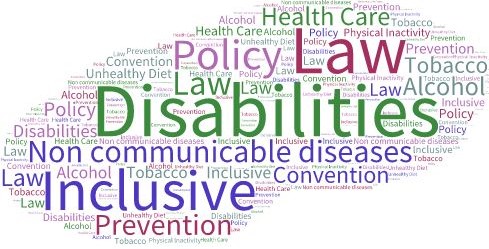Much of my day-to-day work at the O’Neill Institute involves researching and advising on the use of law as a tool to address non-communicable diseases (NCDs). Today, on the fourteenth International Day of Persons with Disabilities, it’s timely to explore the multiple interconnections between disabilities and NCDs.

NCDs are a leading cause of disability across the globe
NCDs, including cancers, cardiovascular diseases, chronic lung diseases, diabetes, mental disorders, and autoimmune diseases, cause almost two-thirds of annual deaths and are a leading cause of disability. Of the years lived with disability in low-and middle-income countries, 65% are cause by NCDs. The number of people living with disabilities is increasing. This is partially due to an ageing population and partially due to the global increase in NCDs.
People with disabilities may be at increased risk of developing NCDs
People with disabilities have higher rates of poverty, less economic participation, lower education achievements, and poorer health outcomes than people without disabilities. Poverty and social exclusion are well known social determinants of health that are linked to increased risk of developing NCDs. Evidence also suggests that some people with disabilities, particularly physical disabilities, may have increased susceptibility to NCDs arising from risk factors such as lack of opportunities to exercise, as well as higher rates of overweight and obesity.
Policies and laws on NCD prevention must be inclusive of persons with disabilities
This year’s theme for the International Day of Persons with Disabilities is inclusion – ensuring access and empowerment for people of all abilities. An important component of inclusion is making sure that public health policies, including NCD prevention policies, are accessible and responsive to the needs of people with disabilities. Most NCDs are caused by four key modifiable risk factors and are therefore preventable. Policies and laws aimed at preventing NCDs typically focus on reducing these four risk factors: tobacco use, harmful use of alcohol, unhealthy diet, and physical inactivity. As public health policy-makers and public health lawyers we have the capacity and the responsibility to develop inclusive policies and programs, such as parks and recreation spaces accessible to people with physical disabilities.
People with disabilities must have equitable access to health care and support services
While NCD policy-making is often focused on prevention, people with NCD-related disabilities must have equitable access to treatment and support services. Article 25 (Health) of the Convention on the Rights of Persons with Disabilities calls for States Parties to provide persons with disabilities with equitable access to health care and health services. Article 26 (Habilitation and Rehabilitation) calls for States Parties to take measures and provide the support required for persons with disabilities to maintain full inclusion and participation in all aspects of life. Given the increase in NCD-related disabilities, such visual impairments and amputations linked to diabetes, countries should be planning to introduce or expand health and support services to ensure that people with disabilities can maintain healthy and productive lives.
Latest
Legal Comments on Medicare’s Site-Neutrality Proposal: A Preview of Potential Litigation
Katie Keith Suhasini Ravi



